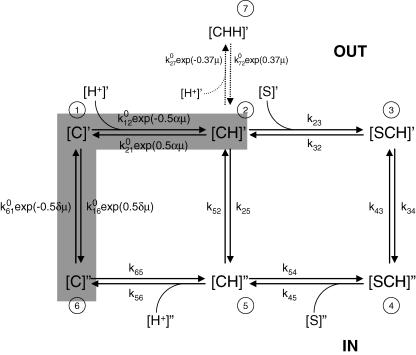Figure 9. Kinetic model for hPEPT1.
A 7-state model in which the empty carrier is negatively charged (apparent valence −1) and one H+ binds to the transporter (C) before the substrate (S). Carrier states at the outer side of the membrane are identified by prime and, at the inner side, by double prime. Details on the transport cycle are given in the Discussion. The partial reaction C2 ⇌ C5 represents the H+-leak pathway (5% of the transport at saturating substrate concentration). Presteady-state currents are due to the partial reactions C6 ⇌ C1 ⇌ C2, marked by the shaded region. Transitions between conformational states are assumed to be first order or pseudo first order, with rate constants kij representing the transition rates from Ci to Cj. Rate constants k12, k21, k23, k54, k65, k16, k61, k27 and k72 are described by voltage-independent values () modulated by voltage and/or ligand concentration, whereas k32, k34, k43, k52 and k56 have a fixed value, and k25 and k45 are obtained by microscopic reversibility (Parent et al. 1992b). The effect of membrane potential (Vm) in k12, k21 k16 and k61 is assumed to follow the Eyring rate theory with symmetric energy barriers (Parent et al. 1992b). α and δ are the fractional dielectric distance coefficients at α = 0.27 and δ = 0.73 (Mackenzie et al. 1996a). The voltage dependence of C2 ⇌ C7 is defined by the empirical coefficient 0.37. μ is the electrochemical potential FVm/RT. To simulate the presteady-state currents in the absence of substrate and the characteristics of Gly-Sar transport, the following set of parameters was used: = 1.5 × 108 m−1 s−1, = 550 s−1, = 105 m−1 s−1, = 200 s−1, = 600 s−1, = 2000 s−1, = 105 m−1 s−1, = 500 s−1, = 1.5 × 108 m−1 s−1, = 35 s−1, = 310 s−1, = 1 s−1, = 10−1 s−1, = 5 × 105 m−1 s−1 and = 800 s−1. The characteristics of cefadroxil transport were simulated by changing , , , and to 1.25 × 104m−1 s−1, 25 s−1, 250 s−1, 1.25 × 104m−1 s−1 and 3 × 106m−1 s−1, respectively. The total number of transporters, estimated from Qmax (Loo et al. 1993), was 7 × 1010, and the temperature was 20°C. The predictions of the model are shown by the curves in Figs 5–7, and given in Tables 1 and 2.

